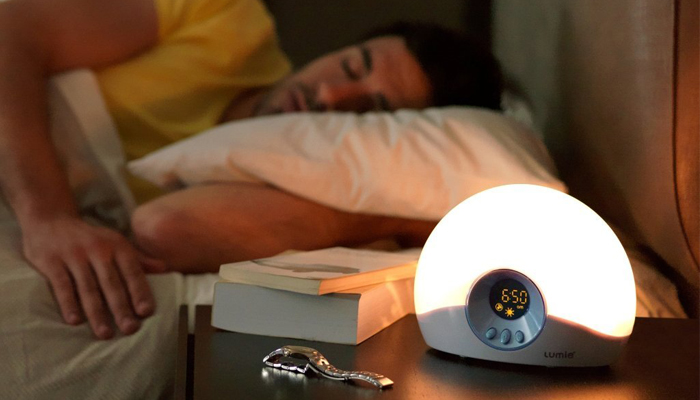
Especially for parents and guardians who are already worried about the school reopening in about two weeks, this article would be a lifesaver. Also for those who might be called back to the office more often in phase three, following the further reopening of other activities, it’s about time you start thinking about waking up early.
I recall having a little cold water splashed onto my face when I was a kid refusing to get up. Sometimes, my parents would even resort to putting ice cubes on my neck. Just the mere thought of it is enough to give me goosebumps. If you’re tempted to do the same to your child or a loved one, I urge you to think twice.
Since everybody’s system is wired differently, it might take some trial and error to find the right way to wake someone up appropriately. Here are some ways you can consider to help safely stir a deep sleeper, including yourself.
Useful ways to wake up a deep sleeper
#1: Music

Image Credits: today.com
According to a recent study this year, people were found to be more receptive to be roused from their sleep by musical sounds than compared to the standard alarm clock ringtones.
We believe that most people would have undergone sensations of sleep inertia in their lifetime. In short, it’s a state of grogginess and disorientation you feel upon opening your eyes. That heavy feeling is definitely not a pleasant experience.
With that said, if you frequently suffer from sleep inertia, using the right tunes may aid you in reducing it. Even if it doesn’t, at least you wouldn’t be awakened annoyed or surprised by the default sounds of your alarm clock.
#2: Wake-up lights

Image Credits: sunnyclocks.com
Those who’ve been to several camps would understand how it feels to be woken up by a sudden surge of bright light. Thanks to the senseless camp committee members on the morning shift, you will have to snap out from sleep immediately.
Having wake-up lights can assist your body to bring you out of sleep slowly. The main idea here is that instead of an instant rush of unwelcoming blazing light, you can program smart light bulbs to get brighter gradually based on the time you set.
Consider purchasing the Philips SmartSleep Wake-Up Light Therapy Alarm Clock with Sunrise Simulation! The light therapy lamp also functions as a bedside reading lamp with 10 adjustable brightness settings. Click through the link to find out more.
#3: Natural lights

Image Credits: homebli.com
For those who prefer more money-saving strategies, make full use of the natural sun rays to get you going in the morning. Opt for translucent curtains instead of room darkening shades to allow the body to be aware when morning comes. Alternatively, one can also choose to leave a little opening on your blinds or your curtains to let the light in when it’s due.
Research has shown that the morning sunlight suppresses the sleep-facilitating hormone, melatonin, and increases your serotonin levels, a natural mood stabiliser to regulate your emotions and support body functions.
#4: Mental stimulation

Image Credits: apkonline.net
When your brain is engaged, you’re seldom sleepy. Deep sleepers who can appreciate stimulating mental activities should go for this method. Set your alarm to wake up to a news radio station to grab your attention and break you away from the sleepy state.
Math enthusiasts who find pleasure solving problem sums no matter the time of the day can download alarm apps like the Mathe Alarm Clock to revive your sleepy head. Want to shut off the alarm? Work your brain in solving multiple-choice math puzzles before you’re allowed to.
Another app called Alarmy is also an option to try. It promises various fun missions which require you to take a photo, solve a math problem, shake your phone up to 999 times, and more! More premium features are included if you’ve exhausted the free ones and need a fresh coat of paint to switch things up.
#5: Keep to a sleep schedule

Image Credits: eatthis.com
We’re sure you’re well aware of a term called “body clock”. Based on a study conducted, having constant variableness in the time you hit the sack and waking up can lead to inadequate sleep. In more severe cases, it may also result in other poor lifestyle behaviours.
If you want to wake up on time without fail, keeping to a consistent sleep schedule is vital. When you have a structured sleep-wake routine, your body’s internal clock can function at its peak. Over time, you will find it a breeze as your body gets accustomed to the process.
All in all, it will take some time before you can find the best strategy to wake up a deep sleeper. With some experiments and try-outs, you will realise them in no time!
Bonus tips for approaching a sleepwalker

Image Credits: LA Times
Unless you are a sleep expert, it’s rather hard to be exactly sure on how to approach a sleepwalker. This is very different from dealing with a sound sleeper.
Do you know that sleepwalking happens in the deep non-rapid eye movement (NREM) stage of sleep? It is a condition where a person can sit up in bed, walk around, eat, or even enter a car for a drive. Some sleepwalkers may even speak, though what they say can make no sense.
As sleepwalkers may unintentionally harm others or themselves, you must return them to bed or wake them up. But to avoid frightening them, you want to do so gently. One way is to direct the person back to their room using as little physical contact as possible. Minimising contact will lessen the possibility of triggering an angry reaction.
Should you try and fail, make a loud noise from a distance to arouse the sleepwalker from their state. Clapping your hands is the quickest way to produce a sound. Presuming that the person wakes up disoriented, softly tell them that they were sleepwalking and accompany them back to the bedroom.
Before you go, we would like to take this chance to strongly encourage anyone who’s struggling with sleepwalking to see a doctor, get a proper diagnosis, and receive treatment.




